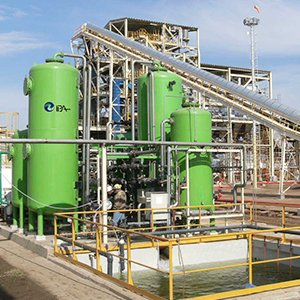Products > Industrial Effluents
DEMINERALIZED WATER
Demineralized water production plants designed and manufactured by IPA ARGENTINA, use reverse osmosis, ionic exchange and/or electrodeionization processes, along with any pre and post treatment step required, without production restrictions.
IPA ARGENTINA has specialized in reverse osmosis system manufacture since 1980, being an OEM acknowledged by the most important membrane producers, i.e. Hydranautics, Dow Chemical, etc. IPA has been an E-Cell system integrator – a General Electric company for its electrodeioniztion systems (EDI) – since 1999.
This wide diversity in technology, allows IPA ARGENTINA to select the most appropriate sequence of processes from a technical and economical point of view, according to the raw water quality and the final composition required. This way, ultrapure water with 18 Mega Ohm resistivity may be obtained even from sea water with over 34.000 mg/l total dissolve solids; automatically, without chemical regenerations and constant produced water quality.
This allows IPA to satisfy demands from applications such as electronic industry, high pressure boilers, metallurgic industry and alimentary industry, etc.
This application may be divided into three main areas:
Make up water, Internal Conditioning and Condensate Polish
Make Up Water:
Depending on the boiler´s features, different treatment for make up water may be required in the operation cycles.
Pre-treatment main processes usually are: decarbonatation, softening, and air force stream demineralization.
Decarbonatation:
Commonly, the decarbonatation comes as a complement for the previous treatment done by using strong cationic exchange resins regenerated in acid cycle.
Softening:
Water softening, generally used for low pressure boilers, is made by using strong cationic exchange resins regenerated by a sodium chloride solution. The purpose is to eliminate calcium and magnesium from the make up water by exchanging those ions for sodium. This way make up water hardness is reduced avoiding boiler possible incrustations by that chemical species.
Demineralization:
It is usually used for high pressure, for steam oriented to turbine boilers feeding. The system reaches a total demineralization, that includes ionic exchange and decarbonatation, which have been the most used ones from last years on.
Nowadays, demineralization processes also include one reverse osmosis pass and a final polish by mix bed ionic exchange resins or the use of an electrodeionizer EDI.
IPA has specialized in water demineralization plants generation, design and construction, based on ionic exchange, reverse osmosis and electrodeionization technologies.
Under its General Electric Corp., E-Cell electrodeionizators system integrator condition, IPA is qualified to select and carry out the proper design for each type of water to treat, according to the expected quality and the operating conditions required.
The proper handling of these technologies allows IPA to provide plants without acid or alkali regenerations and without waste production, with automatic and continuous operation, guaranteeing a permanent water quality, that may reach a resistivity of 18 Mega Ohm cm and < 5 PPB of silica.
Internal conditioning:
Water for boilers internal treatment program is calculated and established by IPA, based on physico-chemical analysis and operation conditions. This way, chemical solutions dosage for each case and the purge regime required may be established, enclosed by continuous activity and involved product concentration monitoring.
Condensate polish:
Condensate water treatment is used, according to the circumstances, to find out the solution for the following troubles:
- Elimination of caustic products from turbine-condensator circuit
- Elimination of mineralization cause by raw water coming in condensator leaks
- Elimination of oils in petrochemical industry condensates.
Many solutions may be customized, where filtration and demineralization join a group. As essential elements they use filters and ionic exchangers, both separate or together:
- Filtration though highly divided products
- High rate demineralization
- High rate demineralization by a cation exchanger follow by a mix bed
- Filtration and demineralization
INDUSTRIAL EFFLUENTS
Compared to sewer effluents, industrial effluent treatment presents basic differences. They are based on flow and charge changes that take place in industrial productions due to the different seasons and different nature of products and waste.
Usually, pre-treatments are quite important because they arrange the waste into a model that can be then treated by physo-chemists and biologists, but in general, they need previous conditioning such as screening, neutralization, equalization, homogenization, specific compound precipitation, filtration, flotation, sedimentation, fat and oil elimination, nutrients adding, etc.
This wide spectrum of pre-treatments require projects offering the best and the most reliable technological alternative in each case and a high grade of expertise in the engineering team in order to adequate the available technologies to each particular case with the greatest success.
The kind of waste spectrum and its features is so extensive that it is hard to enumerate or classify them all, even when each branch of industry has its own specific characteristics.
Besides those domestic sewer effluents classic treatment mentioned, in that related to the biological issue there are important changes to be mentioned for specific adaptation to industrial effluents. There are the processes named, in which we can mention SBR, ICEAS, etc.
